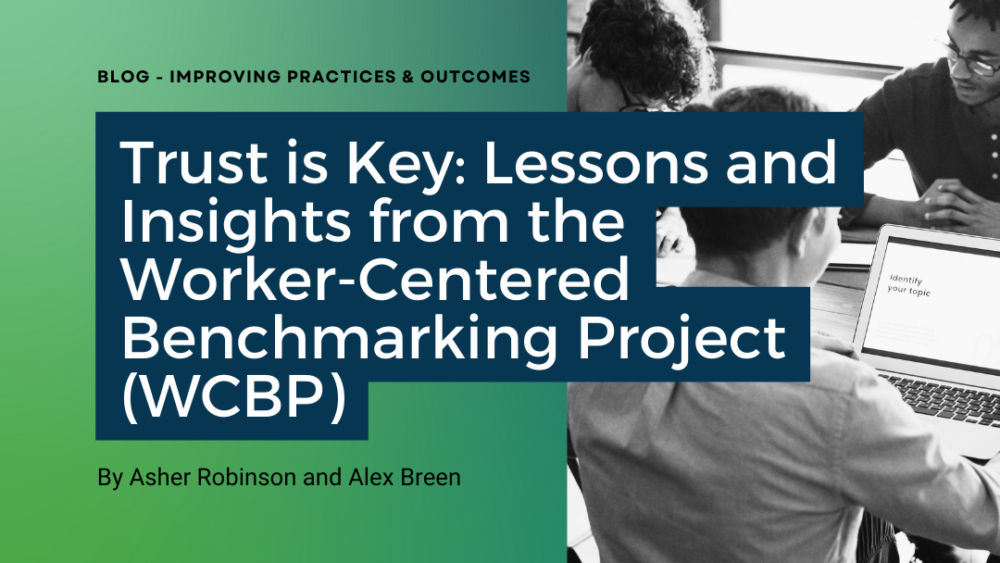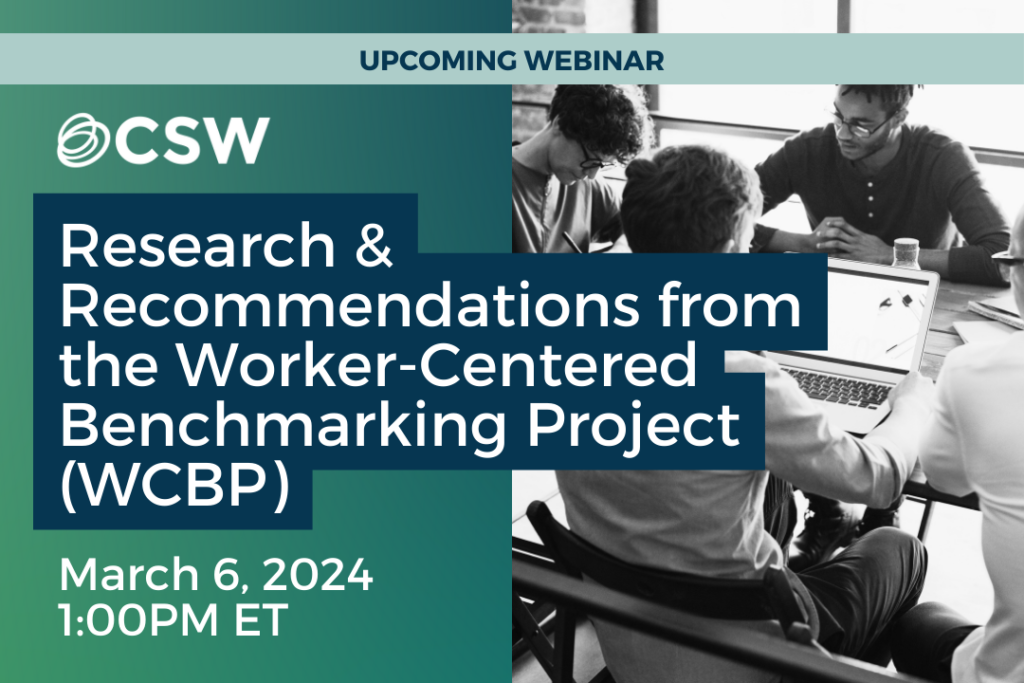The Worker-Centered Benchmarking Project is a participatory action research initiative designed to answer two questions: 1) How do we know if workforce programs are achieving their intended impact within the communities where they operate; 2) How do we know what communities want from workforce programs or even how success is defined? Six workforce development participants and alumni were recruited to form an advisory council, serving as the project’s primary researchers.
The advisory council honed their active listening and effective questioning skills through interviews with direct service providers, intermediaries, and funders before turning their attention to workforce development participants and alumni who had accessed workforce services within the previous calendar year. In total, the advisory council interviewed and surveyed over 175 workforce participants, representing programs ranging from 3 to 365 days.
The following post was written by advisory council member Asher Robinson, who uses the blog to reflect on his experience and key research findings.
Please introduce yourself and discuss why you decided to join the Worker-Centered Benchmarking Project (WCBP):
My name is Asher Robinson; I am first and foremost a transmasc nature lover. I’m a supporter of the arts through my work at Venice Island Performing Arts Center and maintain my connection to the outdoors through service in PowerCorpsPHL’s Urban Forestry Fellowship.
The Worker-Centered Benchmarking Project (WCBP) was shared with me by staff at PowerCorpsPHL, a Philadelphia workforce program that connects people to careers and advances community which I attended in 2023. I saw the WCBP as a notable opportunity for me to maintain and expand upon my participation in the workforce development community. I was drawn in by the combination of the welcoming CSW staff, their commitment to new ways of defining and measuring workforce development program staff, and their focus on centering the voices of workforce development participants in this research.
Based upon your research with WCBP, what metrics should workforce development organizations consider when measuring the success of the programs they operate?
Sense of safety and belonging in a workforce program or at a job
If participants don’t feel safe in the classroom, they will struggle to learn. That is something that we heard repeatedly in interviews with workforce participants who attended programs at community-based organizations, national providers, and on community college campuses.
Through our interviews, we heard from many participants who didn’t feel safe revealing learning disorders in the traditional college classroom but did feel comfortable in workforce settings. This is important and essential for program success. We heard about the importance of measuring workplace safety from female participants entering the restaurant industry. These participants were concerned about their safety in the kitchen. We heard the same thing from other participants in the wake of the COVID-19 pandemic.
As an out, non-passing trans person, confronting the obstacles of public gendered bathrooms can be a challenging and sensitive topic. Before the first day of pre-service orientation at PowerCorps, I was in contact with program staff to ensure my personal safety. Their responses to my questions confirmed that I would be respected and supported and didn’t need to fear reproach for my gender identity in a new social and educational setting.
Workforce programs should use surveys to assess whether participants feel safe, both in the classroom and in the internship or job they are placed into. This is especially important for organizations placing participants into workplaces that are white or male-dominated, or where most of a participant’s coworkers have different life experiences than they do. Asking questions about safety as a follow up measure will let participants know that they are more than just a number.
Changes in self-confidence and self-assurance
One quote really stands out from a Michigan workforce development participant who said “I can get and lose ten jobs in a year. It doesn’t matter. Increased self-confidence and sense of self will stay with me for life.” If the purpose of workforce programs is increased independence and self-sufficiency, then workforce programs should measure changes in how participants view themselves and what they are capable of accomplishing.
I recommend that workforce programs measure changes in participant self-confidence and self-assurance before, during and after workforce programs. Feedback on sensitive subjects like self-confidence should be obtained by peers and not by workforce program staff. This will result in more honest feedback that workforce organizations could use to improve outcomes for the participants they serve.
Your preliminary findings found that a shift in mindset—from fixed to growth—and an increase in confidence, are outcomes that matter to program participants, perhaps even more than getting a job.
What recommendations do you have for workforce development organizations looking to add these and the other metrics that you have named?
Trust is key
If participants don’t trust staff and/or the workforce development organization at large to have their best interests at heart, then any beneficial outcomes become increasingly difficult to attain.
Treat people like people
Making sure everyone — both staff and participants—are treated as a human first and an employee/learner/worker, second. An important quote from a focus group participant has been at the top of my mind: “We’re all humans outside of work.” It’s such a simple statement that holds such a powerful truth.
Pay attention and stay curious
Instead of only having a system of negative consequence in place, have a system that first asks the participant about the issues or barriers they’re facing to gain a better understanding of the situation. From there, you are better positioned to offer advice and support, minimizing further damage from the original source. This method can also offer opportunities for participants to show leadership and management skills, as it relies on them to communicate effectively and work together to find a solution with you.
Begin Gently
Sometimes the hardest part of supportive services is simply bringing participants into their first meetings. When a participant is resistant to accepting support from the start, the most important things to remember are patience and compassion. Compassion for the barriers and blocks that cause and feed into their distance, and patience for the time it takes to build trust. These are essential to closing that distance and enabling the participant to be able to ask for and accept support from others.
Based on what you have learned, what do you think is the biggest challenge facing workforce development organizations?
I think the biggest challenge is a lack of understanding for workforce participants, which fuels the stigma that they’re lesser than those who took the more traditional route of attending college and settling into a career. This bias feeds into the cycle of funders not wanting to invest as much financial support in these programs, because they don’t see the participants as a worthwhile investment. Programs then must make sacrifices in either the services they can provide, or the number of participants they can take in for each program and cohort. I feel there’s a lack of connection and communication between the participants and funders. This must be improved for the field to progress.
You have talked about the importance of having a peer conduct focus groups. What do you think is keeping workforce development organizations from doing that to begin with?
I think first and foremost it’s the bias/assumption I touched on in an earlier question. There’s an assumption that the participants in the programs won’t be professional enough to lead and execute a productive focus group interview. I feel that if workforce development organizations made a point of incorporating time to train participants how to be researchers and interviewers, this could be remedied, and workforce development organizations could begin to implement peer-led interviews in the future.
How have your research findings thus far shifted what you believed about a participant’s experience prior to your research?
I would say the advisory council’s research findings haven’t shifted my beliefs but reinforced them. Time and time again, our findings supported the belief that the more time and effort a workforce development organization puts towards maintaining a welcoming staff supportive services, the more participants feel the effects in their professional and personal lives.
What have you gotten out of your experience on the advisory council?
The experience has been immeasurable for me and more positive than I could have ever guessed. I’ve always had such difficulty with public speaking. Through PowerCorpsPHL I gained so much confidence and realized so many more things were possible for myself. In joining the advisory council, I was able to hone in on that and make use of all the tools and skills I’ve learned along the way. I’ve learned how to become a researcher, how to lead interviews, how to formulate questions, and how to gauge the metrics of success we’ve made together as a team. This experience has affirmed that I’m not only adequate but comfortable and capable of leading this research. Through this experience I now have tangible evidence that my newfound confidence and improved self-esteem will allow me to overcome limits that I used to set on myself that were caused by fear, trauma, and my educational experiences. Across the board, this process has been heartening and full of promise.




Comments are closed.